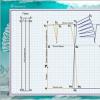Open it in any directory of your computer, where it is convenient for you, for starters, you can use the desktop, a new folder and name it sait. In this folder you will put the site that you select from the project and those pages that you will create yourself. Now let's open another folder in this folder and call it images . In this folder you will add all your graphics: pictures, photos, animation, etc. Open the images folder in the sait folder and not next to it.
To transfer your chosen site (or the Power of Attorney code) to your computer, you need to study the simplest program that comes with any Windows operating system, this program is called "Notepad"
Notebook
Notepad is a text editor designed for editing simple text files. Notepad edits the code of text files, HTML documents, CSS files, and PHP files. which makes it indispensable for the Webmaster. And for you "Notepad" will be the most important tool. Save files edited by notepad, preferably in encodings: Windows-1251, ANSI, Unicod (UTF-8)
Now we open Notepad, for this we go to the section where we turn off the computer and click "All Programs", then click "Standard" and then we find "Notepad" and open it.
Now let's copy the site's source code. (or the "Power of Attorney" code that is written in the "Learning HTML" section). To do this, move the mouse cursor to the top edge of our code, press the left button and circle the entire code to the bottom with the mouse cursor. All code will be colored in Blue colour. Without removing the mouse cursor from the text, so that all the code remains painted blue, press the right mouse button and select "Copy" in the opening window
Now click on Notepad and open it again. Move the mouse cursor to the notepad field, press the right mouse button and select "Paste" in the window that opens.
Everything, the text is now in Notepad.
Now, in the upper right corner of the notebook, click "File" and in the window that opens, click "Save As". A new window will open in front of you:
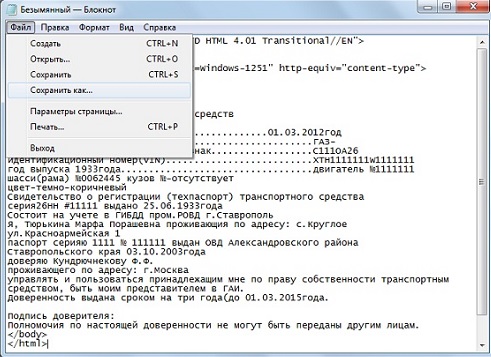
In this window, you need to find your sait package that you created earlier. Now in the bottom section, where it says "File name", you delete everything, most likely * text is written there and write down the name of your site with the htm extension. Those. You should write there for example Longbak.html where longbak is the name of your site and html is the file extension. Don't forget to point. In the "File Type" box a little lower, select All Files
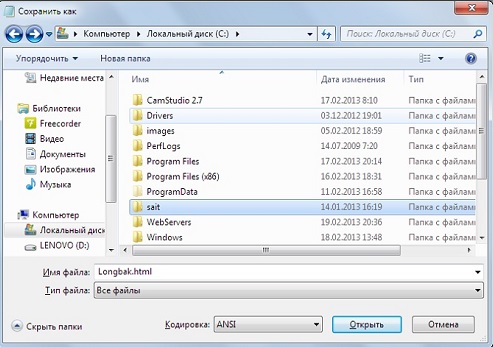
Click Save All site in your folder. You can open the sait folder and open the longbak file in this folder that we just copied and saved. Make two clicks on the file and your site will open in front of you (or the power of attorney that we wrote in the "What is HTML" section) in the browser in which you saved the file. While it is final without pictures, since our "images" folder, which lies next to our file, is still empty, there are no pictures and photos in it, and we do not know how to insert graphic elements into an HTML document. But in order to learn how to insert pictures into the source code of a document, we first need to get acquainted with the construction of tables in HTML
The best way
create new ideas
- to go beyond
human imagination.
"inpropart"
In order to create simple files and make corrections to them, you can use the simple text editor Notepad or Notepad, which is available in any version of the Windows operating system. This editor allows you not only to create files and change their contents, but also contains a text search function. It also allows you to do the simplest replacement of the selected text fragment with another fragment.
There are several ways to open Notepad in Windows. Consider how you can open Notepad through the Start button.
To use the "Start" button, you do not need any special knowledge and skills. Enough to know what is written In this article .
Search the text editor Notepad (Notepad) in the Start menu for a keyword
So, open the Windows search in the Start menu and enter our keyword Notebook. Once the corresponding program is found, it will appear in the list of found programs in the Start menu. In order to start Notepad, all that remains is to click on the link in the list of found programs:
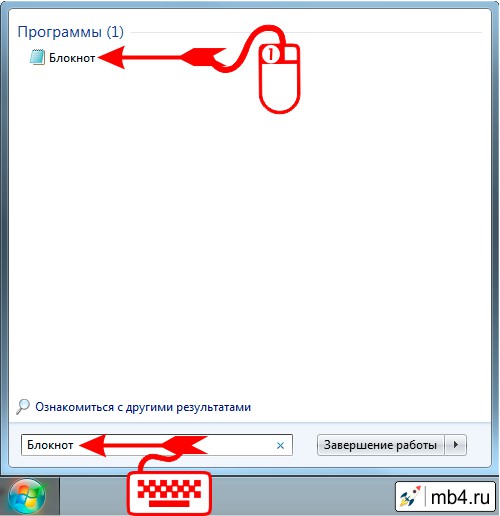
For those who for some reason are used to naming programs in the language of their developers, you can enter a keyword in the search box Notepad. The result will be exactly the same as described above with the keyword Notebook:
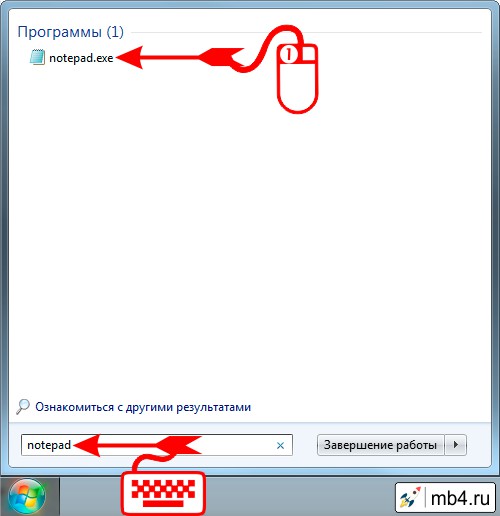
Selecting the text editor Notepad from the Start menu from the list of programs
For those who are used to working with Structured View in Windows, Notepad can be selected from a list of programs. To do this, in the "Start" menu, you need to use the link " All programs”, located at the bottom left of the menu:
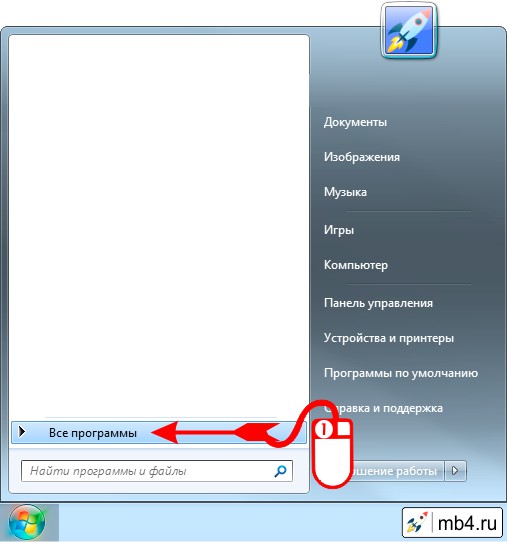
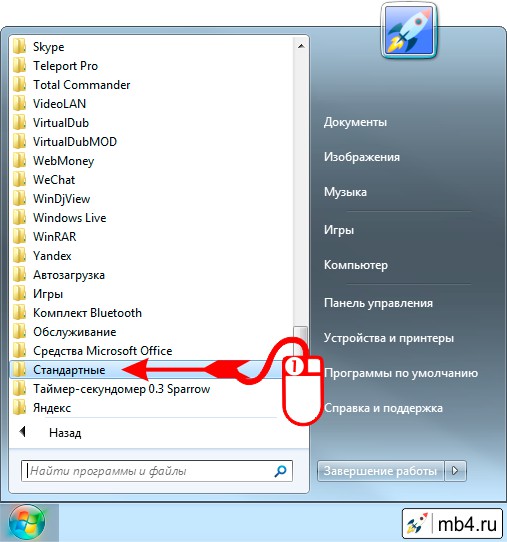
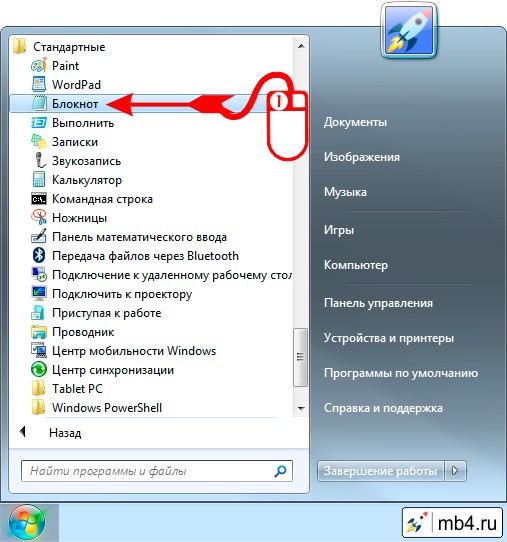
Opening the text editor Notepad
Whichever option is chosen, all of them will lead to the fact that the Notepad text editor window will open, with which we were originally going to work:
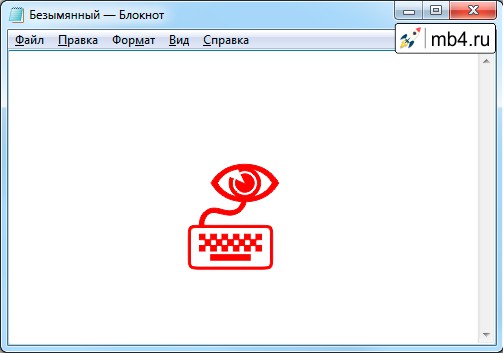
5.
6.
7.
8.
9.
10.
About Notepad
About Notepad
Notepad creates text files.
A text file is a type of file that can be
identify by filename extension .txt.
The default filename is "Unnamed".
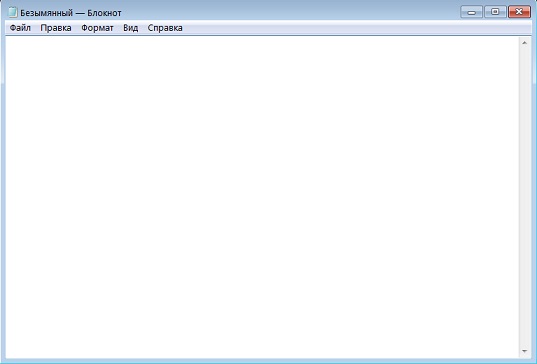
You can also create and edit web pages with Notepad while learning the basics of HTML. Although, judging by my own experience, such complex work as comprehending the basics of the HTML language is better in WordPad, and it is easier to do work in Notepad.
By default, Notepad creates, opens and saves documents with the TXT extension, but you can also open files with the INI, INF, LOG extensions.
To run files of any other type, run the command:
"File" → "Open" → in the file type field, select "All files",
then select desired file.
Notepad allows you to work with texts in ANSI and Unicode encodings,
and also convert from one format to another. To do this, when saving the document, select the desired encoding in the appropriate field.
Suppose you found something interesting on the Internet (news, story,
poems, etc.) - read it yourself and want to send to friends - "highlighted"
the text you liked, “copied” it with the right mouse, “pasted”
first into Notepad, and then already “inserted” - either into an email
friend, or in a message on a social network ("Odnoklassniki", "My World"
etc.), or “saved” in a folder on your computer. Very comfortably!
How to work with Notepad
How to work with Notepad?
Working with Notepad
I will describe in an accessible way, for
novice user, form.
How to find the Notepad program on a computer -
shown in the screenshot on the page Text editors
On the top panel of the program -
File, Edit, Format.
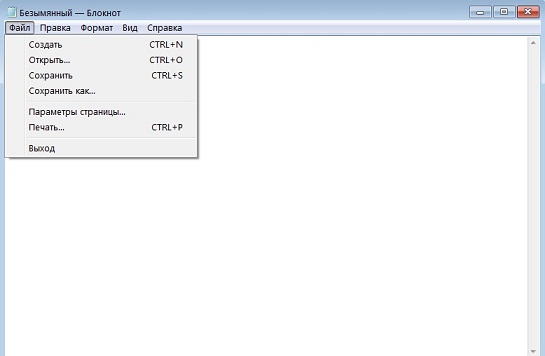 how to create, open, save, print documents in Notepad
how to create, open, save, print documents in Notepad How to create, open,
save, print
documents in notepad
File - "Creates", "Opens", "Saves", "Prints"
documents in notepad.
To create a new document - click "File" → select "New"
and start typing. Or you can not click on "Create". Since you already have Notepad open, you can immediately print and then save your document.
If the document is new, then select "Save as ..." to save.
In the "Explorer" window that opens, select the folder where you will save,
In the line "File name" write the name of the document and click "Save".
To open a previously saved document,
then click "File" - select "Open".
"Explorer" will open with the "Documents" folder, find your previously saved
document and either double-click to open that document yourself, or click
once on that document to highlight it and then at the bottom of the Explorer window, click Open.
Or you can do it without the “File” - find your document yourself in the “Documents” folder and double-click to open it. In all cases, the expected result will be. You will open a previously saved document and you can make changes to it.
If you, in a previously saved document, make any changes,
then click "File" and select "Save".
To print your document
click Notepad's File menu → select Print.
In the "General" tab that opens, select the printer and its settings,
and then click the "Print" button. If you want to change the type of printed
document, click the File menu, and select Page Options.
My Observations on the Vagaries of the Notepad Program
If you will be doing some large print work, then you should consider
that the Notepad program is rather capricious, therefore, in order not to do unnecessary
work - save the document at the beginning of work, i.e. printed the name of the document -
click "File" → "Save as ..." and in the already saved document, typed a short text → click "Save", typed a little more and again → "Save".
And always keep an eye on the cursor - whether it is in the place where you need to type.
How to copy, cut, delete in Notepad
How to "Cut", "Delete",
"Copy", "Paste" in Notepad
"Edit":
"Cut", "Delete", "Copy", "Paste" - already "selected" text.
"Undoes" the last action done in Notepad.
Searches and replaces characters and words in the text.
Inserts the time and date into a text document.
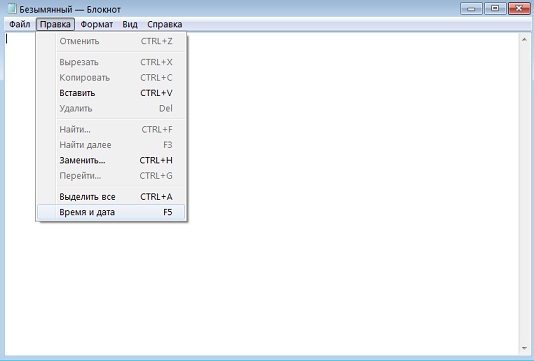
Before removing, cut,
copy, paste - the text must be selected.
How to highlight text in Notepad
How to highlight text in Notepad
"Highlight text" (words)
can be done in two ways:
1.
Put the cursor at the beginning (end) of the text (word) and pressed,
left mouse button, drag the text (word) to the right,
if you put the cursor at the beginning.
And to the left, if you put the cursor at the end of the text (word).
Selected text turns blue.
2.
Place the cursor at the beginning (end) of the text (word), press
and hold the Shift key with one hand while pressing the other
text navigation key, right (→) or left (←).
With text (word) already selected - you can "Cut", "Delete",
"Copy", "Paste". To do this, click "Edit" and do what
what you intended: cut, delete, copy, etc.
In order to remove the "selection" - just click the left mouse
on the white field of "Notepad" or in "Edit" and select "Cancel".
To execute the "Paste" command, you must first copy
(or cut if you don't need the text at that point) selected text
in one place and then put the cursor in the place where you want to paste
text, and then either Edit and choose Paste, or click
right mouse button and select Paste.
If you need to select all the text printed in the document, then press
"Edit", select "Select All" and then click "Edit" again,
choose what you were going to do with this text - cut, copy
or delete.
How to undo the last action in Notepad
How to undo the last action in Notepad
If you cut something, deleted it, etc. and immediately, without taking
any actions in Notepad, change your mind, then click "Edit"
and select Cancel.
The "Undo" command can also be executed with the right mouse button -
just right-click and select from context
Undo menu.
I must say that the "Undo" command in Notepad (unlike WordPad) -
undoes only the really last action. If you, after canceling,
press the "Cancel" button again - the program will return the previously canceled
action. Whereas WordPad - undoes the last action in sequential order.
To make it clearer, let's take a numerical sequence - 1,2,3,4,5.
WordPad will undo first 5, then 4, then 3, and so on. A Notepad, with each
command "Cancel" - first cancels 5, and then returns 5 and again cancels 5.
~~~~~~~
Let me remind you again that the same actions in Notepad
with "highlighted" text: "cut", "delete", "copy",
"cancel", etc. - can be done without going to "Edit".
Press the right mouse button and select from the context menu
what they wanted to do with the text (word).
~~~~~~~
Find and replace characters and words in a Notepad text document
Find and replace characters and words
in a notepad text document
Suppose - you need to find some character or word in the document. For this -
click the Edit menu and select Find. As a result, it will open
such a tab.
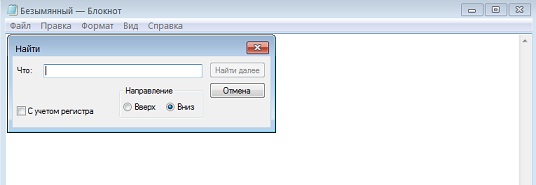
In the "What:" field, enter the text you want to find. In the "Direction" group
click "Up" to search from the current cursor position to the beginning of the document
or click Down to search from the current cursor position to the end of the document.
And click the "Find Next" button. The word or character will be found and highlighted.
If you want to replace one word with another in the text -
then from the Edit menu, select Replace.
A tab will open with two lines.
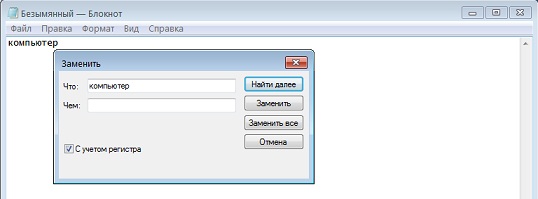
In the line "What:" - enter the word (or character) that you want to replace.
In the line "What:" - enter the word you want to replace. And then
click "Replace". Or "Replace All" if the word you want
replace - repeated several times in the text.
And as a result, the word will be replaced.
How to format a font in Notepad
How to format a font in Notepad
"Format"
"Format" is responsible for formatting
(change) font, style and font size.
If you want to change the font,
font style or font size, then click Format.

Select "Font".
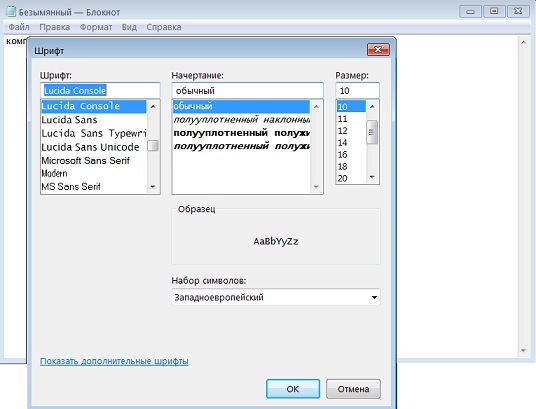
In the new tab, in the "Font" section, you can select a font.
In the "Style" section, you can choose the style (bold, italic).
In the "Size" section, you can choose the font size (12, 14, 16, etc.).
You can, if you want, change the "Character Set"
from Western European to Cyrillic or others.
If you print your document but none of the fonts
in this tab you did not like - you can choose others.
To do this, click on the link "Show additional fonts".
File Explorer will open with many more fonts.
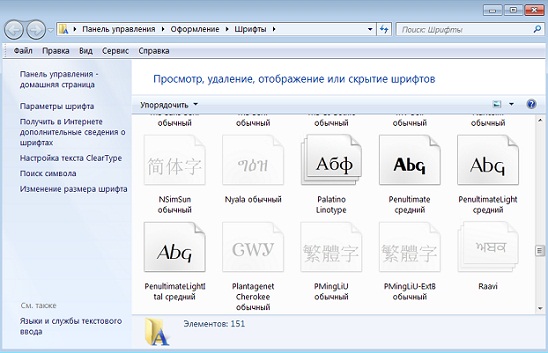
Double click on the one you like
font in File Explorer and a new tab will open.
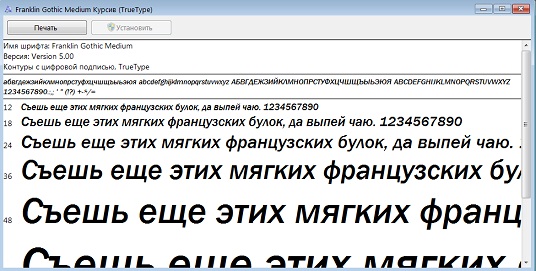
In this tab you can choose the font size
and then click "Print" in the upper left corner.
And more about the font. If you (not for printing, but for normal work in Notepad) have changed the font for only one document, then when you finish working with this document, return the font to its original position. Otherwise, Notepad will exit with a changed font next time.
As you can see, the Notepad program is very simple.
and easy to work with!
One of the most common factors contributing to the acquisition of a computer is the need to work with texts. Such a function is necessary both in offices and at home. For this purpose, there are a large selection of various text editors of varying complexity. But many users who do not know how to handle a computer have no idea how to download and install such an editor. This is not necessary, because operating system Notepad is already built in.
What it is?
It is worth starting with what the Notepad program is for, which is included in the list of standard user programs in any windows system. Designed for quick notes, this tool does not have any special, tasty lotions, such as, for example, the same Word. The interface is ridiculously lightweight and is perfect for both non-professional users and professionals in case of dire need. There are cases of unintentional removal of this program. Or a beginner wants to figure out what, in fact, is the matter, but does not know where to start looking. So where is Notepad located in windows 7?
Opening methods
There are several ways to discover this program and start working in it.
One of these options is quite simple and does not require special computer skills. The first step is to go to the Start menu. This action can be done by hovering the mouse cursor and left clicking. Next is the All Programs tab. It is located immediately above the search bar. We click on this tab and scroll through the list of numerous programs, after which we find the “Standard” tab. Next, we see the desired program. This is the first way we found out where Notepad is located in windows 7.
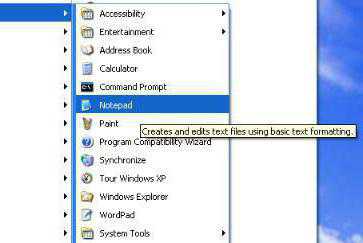
The next method is also quite simple, and it will require much less time than the previous one. Again, holding the computer mouse, we move the cursor straight to the "Start" button. Where is the "Notepad" in windows 7, we will be helped to find out by the same search line located in the lower left corner of the list that opens. We move the cursor over the line, click the left mouse button and start typing the word "notepad". After typing the search word, press the Enter button. Next turns on search system, and after a few short seconds, a window opens on the screen in which we will see a shortcut to the Notepad program. This is another way to find out where Notepad is located in windows 7. Pretty simple, isn't it? And most importantly, it always works.
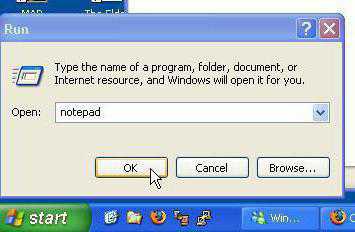
Creating a program shortcut
To prevent questions about where the Notepad program is located in windows 7, it is recommended to place a shortcut to this wonderful program on the desktop. How can this be done?
Based on the first method, after finding Notepad in the list of standard programs, using Start, you need to drag the shortcut to the desktop. You can do this by left-clicking, then holding the button on the label itself and dragging it to the zone that suits you.
It is also entirely possible to conduct an exploratory data collection just to know the location of Notepad. To do this, apply any of the listed methods of detection and after searching, hovering over the desired program again, right-click on it. In the window that appears, find the line "Properties" and press the left mouse button. In "Properties" in the "General" tab there is an exact address where you can find out where Notepad is located in windows 7.
Results
Thus, all the answers to the question of where Notepad is located in windows 7 were considered. The maximum information content of the above instructions will help even the most inexperienced user find a text editor and get to work. After mastering Notepad, you can move on to more complex and professional word processing software.
fb.ru
How to open notepad on windows 7
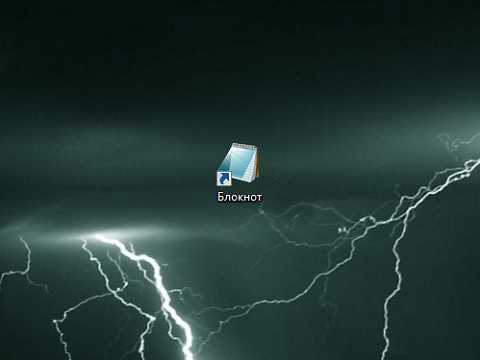
In this article, you will learn how to open notepad on windows 7 in three ways. By the way, the same methods work on most other versions of the windows operating system.
The first way: get to the program manually (it is located in the C:\windows\system32 folder and is called "notepad").
myinformatika.ru
Text editor Notepad
Simple text editor Notepad is used to view and edit electronic documents in TXT format in windows operating systems. This article discusses working in Notepad: how to open, create, save and print documents, select, copy, find and delete text, and change the file encoding.
Text editor Notepad became part of the operating windows systems back in 1985. Then it was first installed on operating systems versions 1.0 and NT. Today Notepad is present in windows 7 and 8.
Until 2000, Notepad had only basic functions and many of them were available from the program menu. The current version of the text editor supports computer keyboard shortcuts, contextual replacement, and Unicode.
As an alternative to Notepad, an MS-DOS text editor called from command line or more functional free program notepad++.
How to work in Notepad
By default, Notepad opens files with the TXT extension, but it can also work with other text documents and html pages on websites. To edit the code, it is still better to use Notepad ++ - it has syntax highlighting.
Open notepad on computer
You can open Notepad in windows 7 using a shortcut on your computer desktop. If you cannot find it in this way, you need to open the Start menu - All Programs - Accessories - here is the Notepad text editor.
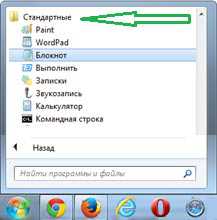
Create, open and save a file
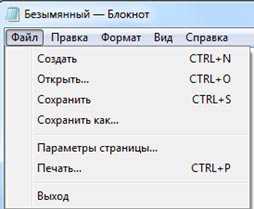
When you open Notepad, there is no need to create a new document, as the working area of the program will be free anyway. All you need to do is write your text and then save the document.
The New command is used when you already have a document open and want to create a new one.
The first time you save a new document, select the Save As option from the menu list. Then, in the window that appears, specify the path - the directory on the computer to save the file, give it a name and click "Save".
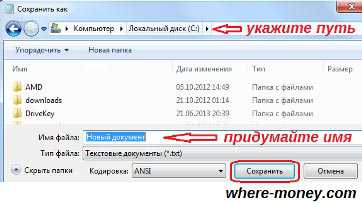
To save all subsequent changes to open document use the "Save" command or press CTRL+S.
print pages
To print a document - go to the "File" menu - click "Print". Next, the "General" window will open - select your printer here, if necessary - configure it, and click the "Print" button.
You can print notebook pages without going to the program menu. In this case, use the keyboard shortcut CTRL + P - it will bring up the "General" window, in it click "Print".
Please note that now we are considering a simple text editor Notepad, working with documents in which may not seem very convenient. Therefore, many users prefer Microsoft program Word - it has more functionality for working with texts.
Find, highlight, copy, cut, paste and delete text
To find a word in notepad, i.e. to search in the text - go to the "Edit" menu and select the "Find" item. You can also press the CTRL+F key combination.
In the window that opens, enter the phrase you are looking for, set the search direction: up / down, and click the "Find next" button.
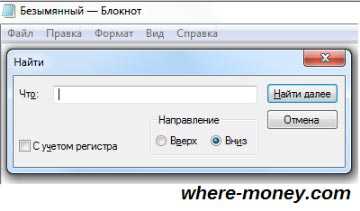
If the search phrase is found in the text, it will be highlighted in bold.
There are several ways to select text in Notepad:
- Place the cursor at the beginning of the text and drag the computer mouse with the left button pressed to the desired area.
- After placing the cursor in the right place and holding down the Shift key, press the left / right button, depending on which direction you want to select the text from the cursor.
- To select all text in the document, press Ctrl+A.
To deselect - click anywhere in the Notepad workspace.
Sections of text highlighted in this way can be:
- Copy - Ctrl+C
- Cut - Ctrl+X
- Paste - Ctrl+V
- Delete - Delete button
The same actions can be performed through the "Edit" menu or by right-clicking and selecting the required command from the context menu.
Undo last action
Let's say you deleted something, inserted it, or cut it out of the text. To undo the last action, go to "Edit" - "Undo" or press Ctrl + Z.
Keep in mind that the Notepad text editor can only undo the last action. Therefore, something made by mistake 2, 3 or more steps back cannot be returned back.
Change default font
To change the standard Notepad font, go to the menu "Format" - "Font". In the window that opens, select the font you like. In the style column, specify the desired option: bold, italic. In the size column, you can choose the font size.
![]()
If none of the proposed font options suits you, click the "Show additional fonts" link and select another one in the window that opens.
Time and date
To display the time and date in Notepad, put the cursor in the place you need, then go to "Edit" - "Time and Date" or press F5.
If you want to paste the time and date on the right side of the Notepad workspace, press and hold the space bar. When the cursor moves to the right place - follow the steps described above.
Change Encoding
The program in question can work with ANSI and Unicode encoding text. To change the encoding in Notepad (convert from one type to another), select the desired encoding when saving changes to the document.
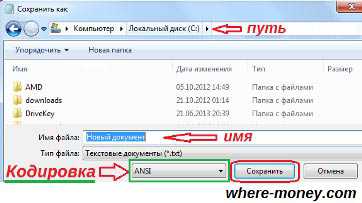
Reference
Notepad Help contains basic information on working with the program. If you have any questions about any of the items described, you can always clarify the details in it.
To go to the Help - select the appropriate menu and open the "View Help" item. Also, you can open the reference materials of the text editor we have reviewed by pressing the F1 key.
where-money.com
Text "Notepad" - how to open and work? Where is the text editor "Notepad" located on the computer?
The excellent windows operating system has provided everything for the user's work. It has everything you need. Let's take a closer look at one of the built-in programs, with a minor, but very interesting and useful, called "Text Notepad". It would seem, why such a seemingly useless program? A “text notepad” on a computer is just what you need to write down your thoughts or small abstracts and stories, and a notepad can also be used to copy links or change the code of various programs. It is simply indispensable for writing down, for example, a phone number or a note, especially when there is no pen or paper at hand, and the matter is urgent.
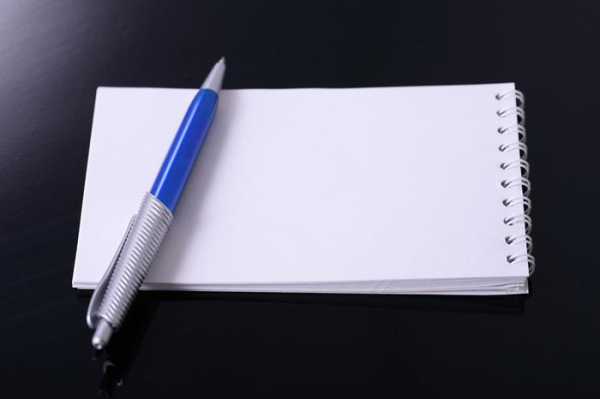
Definition
What is "Text Notepad"? Notepad, or Notepad (its official name) is the most common text editor that is included in the package of windows operating systems (from the very first windows 1.0 and NT to windows 8). In earlier operating systems, it was possible to write (work) in this program only up to 64 kilobytes, and therefore more advanced programs were constantly developed, whose capabilities were less limited. Now these restrictions have been removed, and this editor has become more convenient and practical to use. Also in this program, you can comprehend the code of the HTML language, which allows you to create sites for the Internet and much more. 
Functional
What does the program consist of? What can she do? The menu bar includes five main items: "File", "Edit", "Format", "View", "Help". Each item performs its function.
- The "File" item includes several subsections:
- "New" (CTRL+Z) - this function opens a completely new empty file. This function is very important, especially if the previous file is corrupted or you want to start working in the editor again.
- "Open" (CTRL+O) is the most natural way to open the desired file on your computer. By clicking on this sub-item, select the location of the file and click "Open".
- "Save" (CTRL + S) - everything is clear here. When pressed, the button will save the result of work in a text editor.
- "Save as" - here you can choose the name of the file, the path to save by selecting a folder and clicking the "Save" item. You can also change the ANSI and Unicode encoding of the file when saving.
- "Page settings" - in this sub-item there are parameters for printing - paper sizes, margins, and so on.
- "Print" (CTRL + P) - when you click this button, a window will open in which various options will be indicated - the number of copies, the page range. After clicking "Print", the document will be printed on the printer.
- "Exit" - closes the program. It is also carried out using a cross in the upper right corner. Do not worry about accidentally pressing the "Exit" button, after writing a huge amount of information, the program will automatically ask whether to save this file if it was not done before.
2. "Edit" contains the following:
- "Undo" (CTRL+Z) - this function cancels the last action and returns the document to the state before the action was taken.
- "Cut" (CTRL+X) – the item cuts a fragment of text, placing it on the clipboard.
- "Copy" (CTRL + C) - and this item copies the selected part of the text, which is also placed on the clipboard.
- "Paste" (CTRL+V) – the function is designed to place a text fragment from the clipboard to the part where the cursor is located.
- "Delete" (Del) - deletes the selected part of the text. If you want to return the fragment, just click "Cancel", provided that no other actions were performed in the editor, in addition to deleting the text.
- "Find" (CTRL+F) - using this function, you can find the required place in the text by a phrase or word, as well as select the search direction (from the cursor to the top or bottom of the text). By pressing the "Find" button, the searched text will be highlighted.
- "Replace" (CTRL + H) - this function replaces the words that are searched for in the text. When clicked, a window opens. Having entered the desired word in the “What:” paragraph, in the “What:” paragraph, we write which word to replace. If the word is repeated in the text constantly, just click the "Replace All" button.
- "Go" (CTRL + G) - this subsection moves the cursor to the required line of the document.
- "Select All" (CTRL+A) - this combination makes it possible to select text in the entire document.
- "Time and date" (F5) - inserts the date of the present time at the location of the cursor.
3. "Format" includes only two functions:
- "Word wrap" - this operation allows you to wrap words from lines automatically, the length of the line becomes a limited visible part of the screen. This feature is made for convenience - now you do not need to constantly scroll the worksheet horizontally, trying to read the text.
- "Font" - by selecting this sub-item, you can set the font size, style and appearance. If you are not satisfied with the proposed fonts, then you can select the "Show additional fonts" section and find a new, more interesting and attractive one. By pressing the "OK" button, the font will be changed to the one you have chosen.
4. "View" includes only one function - "Status Bar".
5. The "Help" menu will show you the version of the editor and also answer frequently asked questions. 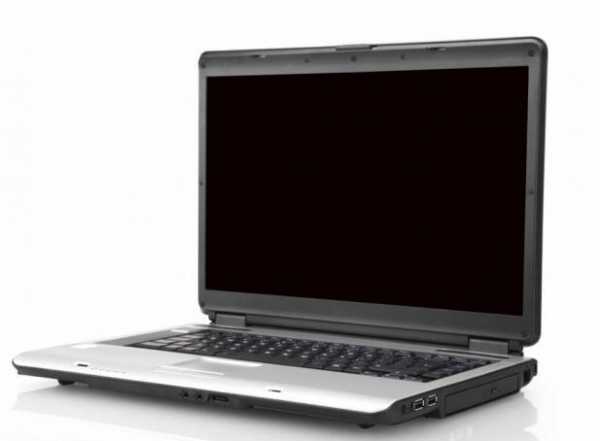
Where to find and how to open
How to open "Text Notepad"? In fact, there is nothing complicated about this, but there are two options. Which one is easier - decide for yourself, the taste and color, as they say, the markers are different. This task is not difficult, and even those who are just starting to get acquainted with the computer and have not yet comprehended all the basics in this matter can cope with it.
Option 1
For the first option, you need to know where the "Text Notepad" is located. Click the "Start" button, which is located in the lower left corner, then select "All Programs", after which a list of different folders and frequently used computer programs will expand. In this list, you need to find the "Standard" folder. It is in it that Notepad is located - a text editor. 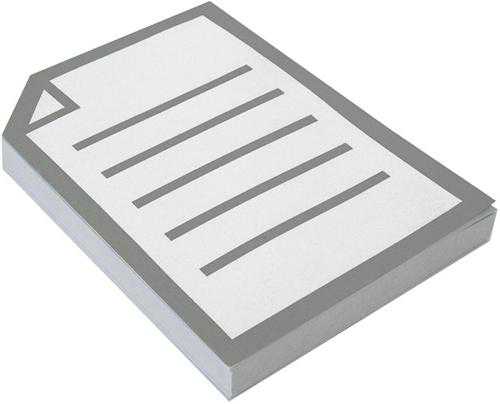
Option 2
Is there some more easier way completely different from the first one. To get started, right-click on an empty spot on the desktop, after which a small menu will open, select the "Create" item from the list, and another small list will open, select the "Text Document" line in it and give a name to the new document. Everything, you can work in notepad. Now you are probably asking: “How can I open this file with a text notepad?” Yes, it's easier than ever! Just right-click on it and in the list that appears, find the line "Open with Notepad (or Notepad)".
Note
The main difference between the first option and the second one is that in the first case we first write down all the necessary information, and then we create a file and save it there, and in the second case, on the contrary, an empty document is first created, which is then replenished with our records. 
Analogues
Notepad++ - very interesting program, but its true purpose is to work with HTML code. Unlike the classic windows editor, Notepad++ can deal with several files at once, and at the same time. It has no conflict with the file encoding, and in case of any error, highlights it in red.
NFOPad
NFOPad is another great program. It independently determines Internet links and addresses email, which the standard “Text Notepad” built into the operating system cannot do. Also this program supports NFO format. 
AkelPad
At first glance, this editor is no different from the standard one, but it is not, it has the function of previewing the file being opened. And the most important advantage of this program is that in the absence of the necessary function, you can simply write it yourself and insert it into the editor, which, of course, the usual “Text Notepad” cannot do. This function is very useful for those who are familiar with the basics of programming.
fb.ru
Text notepad on computer
A text notepad on a computer is used mainly as a memo in the form of text entries, also a notepad is a text editor in which you can change the font of the written text, paste text into it, copy text from the notepad and delete all or part of the text. You can create a notebook on your computer on the desktop or in File Explorer, and you can launch a new notebook on your computer through the Run command.
How to make a notepad on a computer
To create a text notepad, you need to move the mouse pointer over an empty space on the desktop or on the right side of the open explorer and click on the right mouse button in the context menu that appears, first select "Create", and then "Text Document".
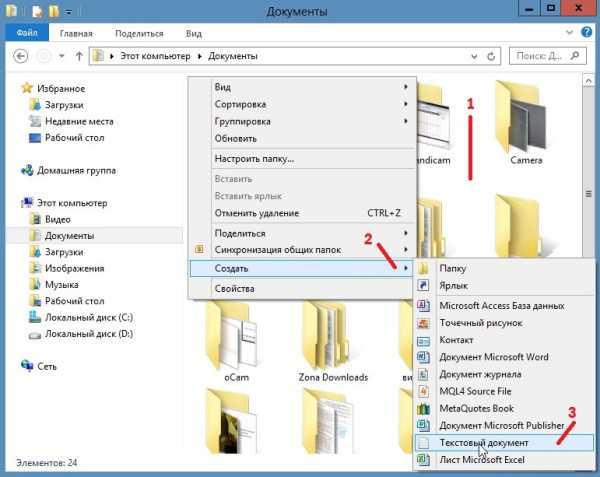 How to create a notepad on the desktop or in File Explorer
How to create a notepad on the desktop or in File Explorer After that, a file called “New Text Document” will appear in the explorer at the very bottom, this name can be immediately replaced with another name.
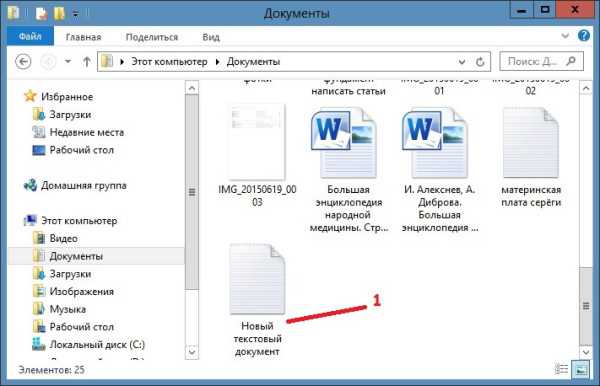 This is what the generated text file looks like
This is what the generated text file looks like By opening this document, you can make some notes in it and close it with saving, and after the next opening, you can read your notes and make corrections and close again with saving.
How to open a text notepad on a computer
You can open Notepad on your computer through the "Run" command, which is launched by simultaneously pressing the WIN + R keys on the keyboard.
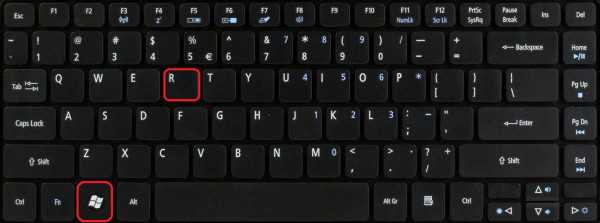 Run the execute command
Run the execute command In the Run command that opens, you need to enter the command "notepad" and click the "OK" button.
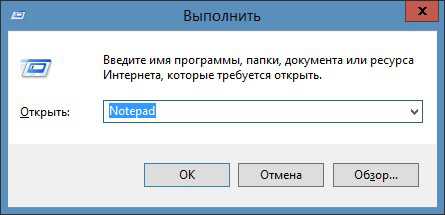 Let's create untitled notepad to your computer for free
Let's create untitled notepad to your computer for free After that, a blank notepad called "Untitled-Notepad" will immediately open.
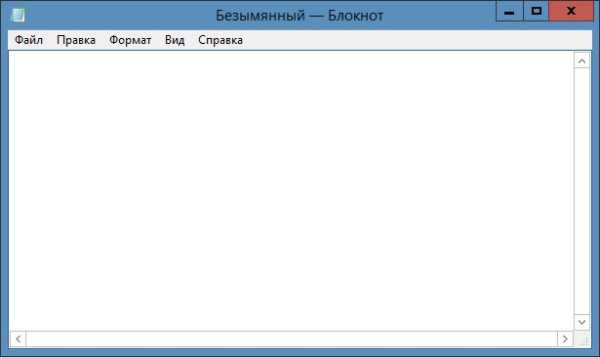 A lot of what you need a notepad in the computer
A lot of what you need a notepad in the computer In this notebook, you can make some notes and close it with saving. When saving, you need to give a name to the text file and determine the location where it will be located.
Practice shows that most users use Notepad only to view existing text documents, but they edit the text, even when it is the ASCII format that is required, in others, more convenient programs. However, Notepad, due to its conciseness, is great for studying this entire class of programs: what is in Notepad is also in any other text editor.
Interface
So, the Notepad text editor is a standard Windows application that has a main menu and a text editing field. Let's start with the menu: in File there are New, Open, Save and Save As. The first removes the text (if any) from the editor, preparing the field of activity for creating a new document. With the help of the Open and Save items, you can load files for reading and modification, respectively, and save them. If you want to save the file under a different name after editing, select Save As. The Page Layout and Print items available there are useful if you have a printer and want to print something from this program.
The following is the most useful menu for a text editor - Edit. The first point is the most important conquest of the information industry - Cancel. That is, if you inadvertently erase all the contents or do something else unnecessary, immediately use the undo of the last action (Ctrl + Z). Following Undo are menu items for working with the clipboard: Cut (Ctrl+X), Copy (Ctrl+C) and Paste (Ctrl+V). They may be unavailable if there is no text selected in the editor (for Copy and Cut) or there is no text in the clipboard (for Paste). Item Delete (Del) allows you to delete the selected text.
Using the Select All item, you select all the text in the editor, and Date/Time (F5) inserts the current date and time in the format set in the system. Further, in the View menu there is a very important item Wrap by words. When checked, lines that do not fit entirely in the editor window are automatically wrapped. Otherwise, they will go to the right, out of view, and you will have to use the horizontal scroll bar to correct it or just read it. Finally, the Font item opens a standard font selection dialog, with which you can change the font that will be used to display text in Notepad. In this window, you select the typeface, style, and size of the font. All changes are promptly displayed in the Sample window. It is also useful to indicate the set of characters used - Cyrillic, otherwise you risk seeing abracadabra instead of Russian letters.
Then come the search items - Find, Find Next (F3), Replace and Go To. If you haven't searched since opening the program, selecting Find or Find Next will open the search window. In it, in the Sample line, enter what you are looking for, and then click on the Find Next button. If the Case-sensitive option is enabled, lowercase and uppercase letters will be distinguished during the search. For example, if you write "Moscow" and search with the case recognition option enabled, the program will be able to find the word "Moscow" in the text, but not "MOSCOW". If the option is disabled, then both options will be found. Finally, Direction determines whether text should be searched up or down from the current cursor (caret) position.
Another great feature of Notepad is the ability to not only search for text, but also to replace it. To do this, from the Edit menu, select Replace (Ctrl + H). At the same time, if you had a selected text fragment at the time you called the replacement window, it will immediately be entered in the search bar (What). After determining what to look for, it remains to enter in the replacement string (What) what you want to replace what you are looking for, and click one of the Find Next, Replace or Replace All buttons. The first one finds the closest match (the search goes from left to right, top to bottom), the second allows you to replace the found one, and the third one replaces the text in the entire document at once.
Entering and editing text
Text input is made from the keyboard, and the character is entered from the place where the cursor is located. To enter an uppercase character, use Shift, switching between Russian and English is carried out in accordance with Windows settings(usually by Alt+Shift or Ctrl+Shift). To start a paragraph or a new line, press Enter, to align text in columns (for example, if you enter tabular data), it is preferable to use not spaces, but tabs. If you make a mistake when entering, then the last character is deleted by pressing Backspace (the button is located on the right in the main block of keys, a left arrow is drawn on it), and to delete the character following the cursor, use Delete. You can also edit text with the mouse. Double-clicking selects the word, pressing the left mouse button and moving the pointer also selects the text. Then, on the selected text (it is highlighted by inversion, as shown in Error: cross-reference source not found), you can perform manipulations such as copying or cutting to the clipboard, deleting or replacing with text from the clipboard. If at the moment of pasting from the buffer there is a selected text in the program, then it will be deleted, and the contents of the clipboard will fall into its place.
Rice. 11.2.
Moving through the text in almost all editors is carried out by the same keys or their combinations - they are listed in Table 11.1.
| Key or combination | Action to take |
|---|---|
| Left Arrow | Moves the cursor one character |
| Right Arrow | Moves the cursor one character to the right |
| Up arrow | Moves the cursor up one line |
| Arrow to down | Moves the cursor one line down |
| Ctrl+Left Arrow | Moves the cursor one word to the left |
| Ctrl+Right Arrow | Moves the cursor one word to the right |
| Home | Moves the cursor to the beginning of the line |
| End | Moves the cursor to the end of the line |
| ctrl+home | Moves the cursor to the beginning of the document |
| ctrl+end | Moves the cursor to the end of the document |
| Page Up | Moves the cursor up one screen |
| Page Down | Moves the cursor one screen down |
To start selection from the keyboard, press the Shift key and, while holding it down, select the desired text using the same keys that are used to move the cursor.
If the document is large enough, then the best way to move around is to search: call the search dialog through the menu, enter the word, symbol or phrase you are looking for and click Find next. The found match will be highlighted, and the document will be scrolled accordingly to the desired location. If the found fragment is repeated, then to find the next one, just press F3.
Printing Documents
To print a document from Notepad, just use the Print item from the File menu. By default (with standard settings in the Russian version of Windows XP), when printing, the header is not displayed, and the word "Page" is printed as the footer. If this does not suit you, or you want to change the page orientation from portrait to landscape or change the width of the margins, then use the Page settings item, which displays the window of the same name (Fig. 11.3).
NOTE
In fact, a header with the file name should be displayed on top, and its number should be printed below after the owl “Page”. This does not happen for the reason that the symbols used to determine the parameters have been translated into Russian, while the program itself does not accept commands from Cyrillic characters.
Rice. 11.3.
In it, you can specify the size of the sheet, its location, as well as the width of the margins. All this will be schematically displayed in the sample field. In addition, if the printer has multiple paper feed trays, you can select the one you need from the Feed list.
As for headers and footers, you can either disable them altogether by removing everything from the header and footer fields, or replace their content. So, you can write your own text and enter symbols for automatic substitution, which will be replaced with the desired values when printed. All of them are shown in Table 11.2.
If you want to display the character "&" itself, then you should repeat it: "&&".
2011-07-04 // Any questions, suggestions, comments? You can


